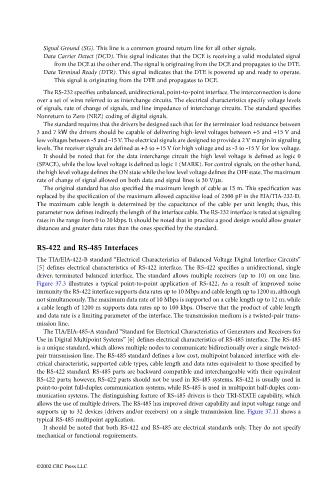Page 1062 - The Mechatronics Handbook
P. 1062
Signal Ground (SG). This line is a common ground return line for all other signals.
Data Carrier Detect (DCD). This signal indicates that the DCE is receiving a valid modulated signal
from the DCE at the other end. The signal is originating from the DCE and propagates to the DTE.
Data Terminal Ready (DTR). This signal indicates that the DTE is powered up and ready to operate.
This signal is originating from the DTE and propagates to DCE.
The RS-232 specifies unbalanced, unidirectional, point-to-point interface. The interconnection is done
over a set of wires referred to as interchange circuits. The electrical characteristics specify voltage levels
of signals, rate of change of signals, and line impedance of interchange circuits. The standard specifies
Nonreturn to Zero (NRZ) coding of digital signals.
The standard requires that the drivers be designed such that for the terminator load resistance between
3 and 7 kW the drivers should be capable of delivering high-level voltages between +5 and +15 V and
low voltages between -5 and -15 V. The electrical signals are designed to provide a 2 V margin in signaling
levels. The receiver signals are defined as +3 to +15 V for high voltage and as -3 to -15 V for low voltage.
It should be noted that for the data interchange circuit the high level voltage is defined as logic 0
(SPACE), while the low level voltage is defined as logic 1 (MARK). For control signals, on the other hand,
the high level voltage defines the ON state while the low level voltage defines the OFF state. The maximum
rate of change of signal allowed on both data and signal lines is 30 V/µs.
The original standard has also specified the maximum length of cable as 15 m. This specification was
replaced by the specification of the maximum allowed capacitive load of 2500 pF in the EIA/TIA-232-D.
The maximum cable length is determined by the capacitance of the cable per unit length; thus, this
parameter now defines indirectly the length of the interface cable. The RS-232 interface is rated at signaling
rates in the range from 0 to 20 kbps. It should be noted that in practice a good design would allow greater
distances and greater data rates than the ones specified by the standard.
RS-422 and RS-485 Interfaces
The TIA/EIA-422-B standard “Electrical Characteristics of Balanced Voltage Digital Interface Circuits”
[5] defines electrical characteristics of RS-422 interface. The RS-422 specifies a unidirectional, single
driver, terminated balanced interface. The standard allows multiple receivers (up to 10) on one line.
Figure 37.3 illustrates a typical point-to-point application of RS-422. As a result of improved noise
immunity the RS-422 interface supports data rates up to 10 Mbps and cable length up to 1200 m, although
not simultaneously. The maximum data rate of 10 Mbps is supported on a cable length up to 12 m, while
a cable length of 1200 m supports data rates up to 100 kbps. Observe that the product of cable length
and data rate is a limiting parameter of the interface. The transmission medium is a twisted-pair trans-
mission line.
The TIA/EIA-485-A standard “Standard for Electrical Characteristics of Generators and Receivers for
Use in Digital Multipoint Systems” [6] defines electrical characteristics of RS-485 interface. The RS-485
is a unique standard, which allows multiple nodes to communicate bidirectionally over a single twisted-
pair transmission line. The RS-485 standard defines a low cost, multipoint balanced interface with ele-
ctrical characteristic, supported cable types, cable length and data rates equivalent to those specified by
the RS-422 standard. RS-485 parts are backward compatible and interchangeable with their equivalent
RS-422 parts; however, RS-422 parts should not be used in RS-485 systems. RS-422 is usually used in
point-to-point full-duplex communication systems, while RS-485 is used in multipoint half-duplex com-
munication systems. The distinguishing feature of RS-485 drivers is their TRI-STATE capability, which
allows the use of multiple drivers. The RS-485 has improved driver capability and input voltage range and
supports up to 32 devices (drivers and/or receivers) on a single transmission line. Figure 37.11 shows a
typical RS-485 multipoint application.
It should be noted that both RS-422 and RS-485 are electrical standards only. They do not specify
mechanical or functional requirements.
©2002 CRC Press LLC

